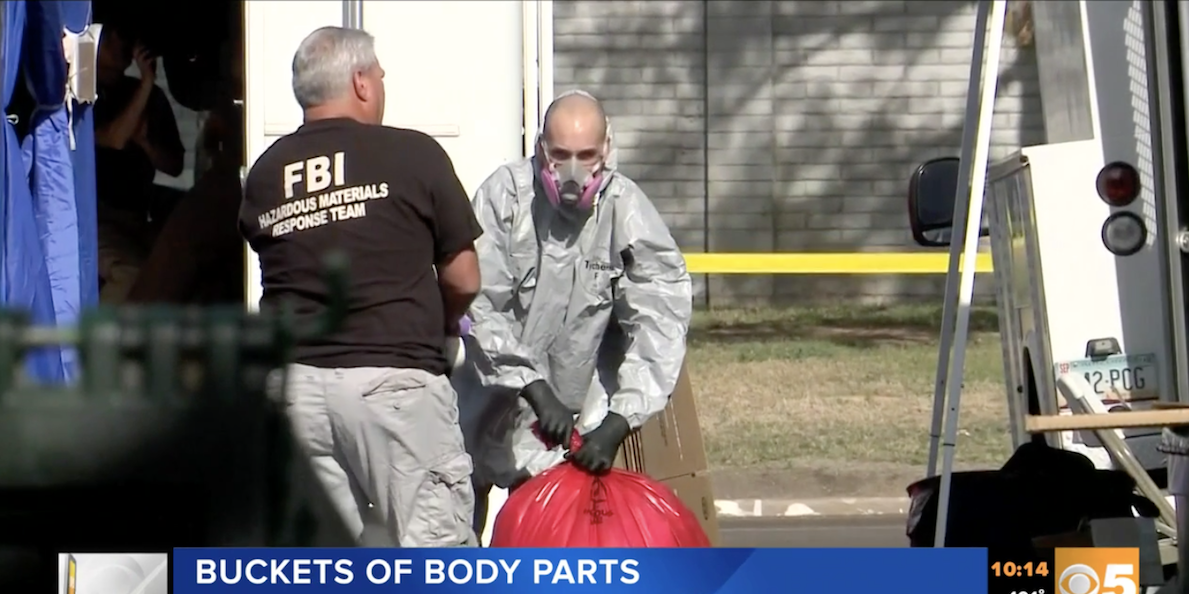- Warning: This story contains graphic details.
- A 2014 FBI raid of a for-profit body-donation center in Phoenix, Arizona, found a woman’s head sewn onto a larger man’s torso, among other gruesome discoveries.
- It’s not clear why someone at the centre did it, but Philip Guyett, a former “body broker,” offered a surprising theory.
- Body-donation centers, like that in Phoenix, often take dead bodies from relatives in exchange for the person’s ashes. The center then extracts body parts from the cadaver, and sells them to third parties.
- The Arizona center might have sewed another person’s head on in order to make up a full human body to amass enough bones to cremate for their families, Guyett told Business Insider.
- Visit Business Insider’s homepage for more stories.
A former “body broker” has a surprising theory for why the FBI found different body parts sewn together in a 2014 raid, the gruesome details of which were revealed in court documents in July.
During the raid of the Biological Resource Center (BRC) in Phoenix, Arizona, FBI agents found a woman’s head sewn onto a larger male torso – like “Frankenstein” – and hung on a wall, among other gruesome discoveries, according to court documents reported by the Arizona Republic and the local KTVK news station.
BRC is currently being sued in a civil lawsuit, with some family members who donated relatives’ bodies to the center saying that it did not treat the bodies of their loved ones with dignity or respect.
Stephen Gore, the Biological Resource Center’s owner, pleaded guilty in 2015 to operating an illegal enterprise and was sentenced to one year deferred prison time and four years probation.
It remains unclear why the now-shuttered center sewed the different body parts together. But Philip Guyett, a former "body broker" - who for six years collected dead bodies from funeral homes, recovered body parts for transplant, and sold them to third parties - offered a surprising theory.

Many families who can't afford to cremate their relatives donate various body parts to body-donation centers - like the one Guyett ran, or BRC - in exchange for their cremation and the subsequent return of the ashes.
The only body parts that turn into ash are a person's bones. So the Arizona center might have taken away too many of a dead person's bones, and was trying to sew together different people's parts to make up a full body's worth of ashes, Guyett told Business Insider.
Here's his theory:
"If I knew that a family wanted their ashes back, I'd be doing limited recovery [of internal organs or tissues] so that they would get 90% of that bone ash back.
"[But] these other people, they take everything. They'll take the arms, the shoulders, the spine, the hip, and basically all the family would be left with is maybe a cup's worth of ashes from a leftover rib cage or something.
"So I think the family wanted the ashes back, and [the Biological Resource Center] took some body parts that they didn't have to get back, just to make up the volume.
"That would be my assumption because there's no other reason to go through that work of trying to put the body parts back together again."
"It's not normal," he added.

Guyett told Business Insider that his business was entirely legal, and that relatives had explicitly given permission for him to take parts of their loved ones' bodies for research.
His clients included private universities and researchers that needed specific body parts for their teaching exercises. They would require various body parts - from brains to skin grafts to various tissues - to test out new medical technologies, and carry out research of the human body for science.
While his business as a whole was legal, in 2009 Guyett was sentenced to eight years in federal prison for falsifying the medical records of some cadavers that he wanted to sell for transplant.
He served six-and-a-half years, during which time he wrote a book about his experiences - titled "Head Shoulders Knees & Bone$."
"I don't regret being in the business," Guyett, who now works as a land surveyor in Southern California, told Business Insider. "I regret some of the things I did, obviously, but the business was interesting. And I think life should be interesting."
Single cadavers are generally used for several purposes
One cadaver is typically cut up into various body parts, which would then be sold onto a range of buyers - including the US Army.
One man in Arizona is currently suing BRC after finding out that his mother's body, which he donated in hopes that it could be sent for Alzheimer's research, had been sold to the US Army to test the effects of roadside bombs on troops.
The Army said when the case was first reported that it was unaware the family had not given consent for such testing.

Here's how BRC divided up a body that belonged to an Arizona man named Conrad Patrick, and where it sent the parts, according to a 2017 Reuters investigation:
- His left foot went to a Chicago-area orthopedic lab.
- His left shoulder was sent to a Las Vegas company that holds surgical seminars.
- His head and spine went to the US Army for an unidentified project, even though Patrick explicitly said while he was alive that he did not wish to be used in military or destructive tests.
- His "external reproductive organs" went to a local university.
- His right foot and left knee were placed in the company's freezers, to add to BRC's inventory.
"The operations can resemble meat-packing plants," Reuters reported of BRC at the time.

